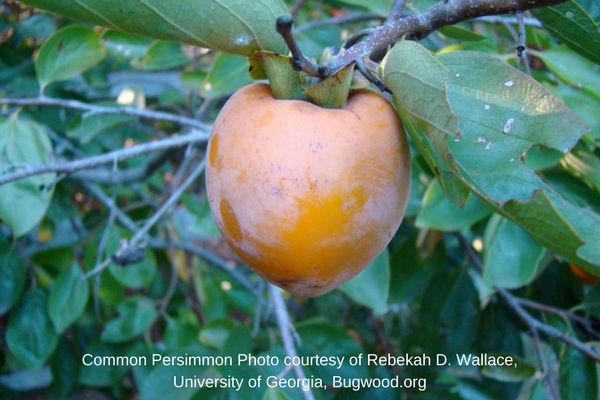The fall months are typically when we think about harvesting and eating apples, but there is another great fall ripening tree fruit, Persimmon.
Persimmon, Diospyros virginiana, is a native tree with an edible fall maturing fruit. This tree grows 35-60 feet tall and 20-35 feet wide. The oval-shaped leaves of persimmon are arranged alternately on branches. They are dark green above and pale green on the leaf underside. Persimmons are dioecious, meaning trees have either male or female flowers, but not both. Dioecious plants require both male and female trees to produce a fruit crop, a pollinator tree is necessary. The small flowers on the tree are white to greenish white and found in clusters on the outer edges of the tree because the tree blooms on new wood. The fruits are orange, rounded, 1-1.5 inches in diameter, and have a 4-part calyx on top. The fruits mature in September to October after the first hard frost of the year. The fruit needs to be completely ripe and soft before they are eaten otherwise they are very astringent and inedible.
The native persimmon is the more commonly used persimmon in Nebraska because it is much more cold-hardy. There is also an oriental persimmon that would not be as tolerant of our cold temperatures. There are a few good choices of native persimmons to look for when shopping for your persimmon tree. ‘Early Golden’ is a good choice for early ripening fruits that are excellent quality, firm fruits. ‘Miller’ is a very productive variety with large, firm, flavorful fruits. ‘Woolbright’ is a productive tree with good flavor, but the fruits tend to split.
Persimmon is a great tree; if started from a container or balled and burlap and planted in your landscape at a young age. This tree, however, is difficult to keep alive when transplanted from one site to another. It grows best in full sun, but will tolerate some shade. Persimmon prefers to grow in moist, well-drained soils, but will tolerate drought conditions. This is a great acreage tree because it suckers well and can form a large stand. In addition, it makes a great urban tree, because it tolerates city soils and urban growing conditions.
Persimmon produces a great wood that has been used for golf club heads, billiard cues, flooring, and veneer according to Michael Dirr in the Manual of Woody Landscape Plants. It is a tree that is not browsed by deer. However, it is a good plant for wildlife because the fruits are eaten by raccoons, skunks, opossums, and foxes among other wildlife. Be careful with this species in areas where horses are kept because it can cause illness and death to horses if they eat the fruits, according to Michael Dirr.
Persimmon is a great tree for the overall shade and aesthetic value, but it will also produce a tasty fruit. They grow in many different locations and will even colonize given the opportunity. There are a lot of great varieties to choose from for different fruit characteristics. So, when a new planting opportunity presents itself on your landscape, look to persimmon for beautification as well as fruit production.

